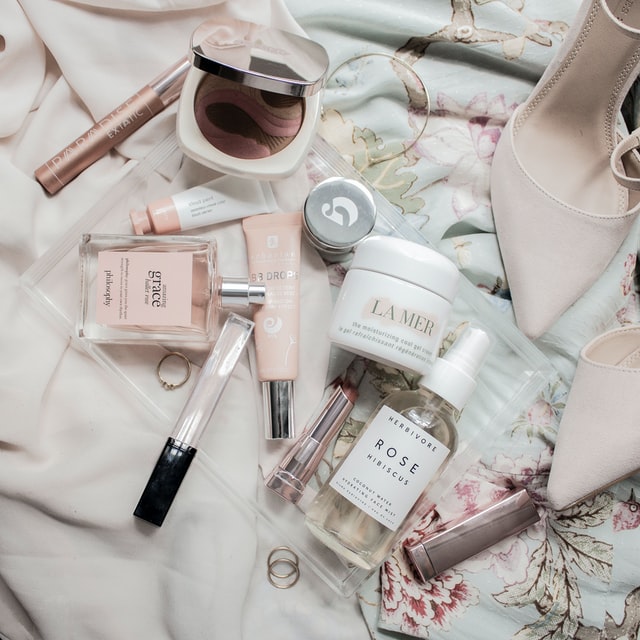
The price of beauty: Corporations’ influence on women’s identity and practices
Article by Maria Mhawej
Photo by Johanne Kristensen on Unsplash
For women, the average routine is usually a variation of this: You wake up. You wash your face and use skincare products promising a glowing and youthful appearance. Next, you apply makeup that highlights your most attractive features and hides any blemishes. You then get dressed in clothes that fit to accentuate your curves. Occasionally, you may shave to eliminate any undesirable body hair. You may have even taken advice from one of the beauty industry’s countless guides outlining how to set up the ‘best’ routine in this way.1
Surely these are just products and practices women choose to use, right? Examining corporations’ history says otherwise.
The rise of corporations
In their 16th century emergence, corporations were feared to have a manipulative nature, with the public reluctant to trust them. Initially banning them in 1720, Members of Parliament notably warned that such a business model would be immoral and irresponsible.2
As corporations grew, there was a shift to prioritise shareholders and focus on generating profit. This financialization reaffirms MPs’ initial concern because aiming to accumulate money above other goals – like working for the public good – arguably fuels a system that values monetary growth over consideration of non-financial social and environmental consequences. The cosmetic and fashion industry reflects a similar nature, particularly in their persuasive advertising campaigns.
The world beauty industry developed post-World War II, as living standards rose and social norms began to change. International cosmetics companies like Unilever took advantage of this, selling ranges of ‘essential’ products.3
Advertising: manipulative beginnings
Moreover, not only have women’s routine products come from corporations but so have the cultural expectations prompting them to shape themselves in this way. Historically, corporations have largely impacted women’s cultural practices, such as Gillette’s advertisement campaign in the 1900s. At the time, women did not widely shave body hair, especially as the norm was to wear clothing that hid much of their bodies. Motivated to increase its razor sales, Gillette pushed women to remove any visible body hair as they emphasised it to be “superfluous”, “ugly” and “unwanted”.4
The magazine industry intensified this by warning that women should maintain their appearance accordingly, lest face losing their partner and home security. This style of marketing resulted in an overwhelming majority of women incorporating body hair removal in their personal routines to maintain a tidy, attractive, and hygienic identity. Thus, what started as Gillette’s desire to expand its target market became a culture associating body hair with being unfeminine and in need of removal.
Influencers and trends
Years later, the beauty industry’s advertising methods still exploit women’s insecurities. While many corporations build their branding in a similar way by associating their product with desirable femininity and feminine goals, others are using social media and the power of social circles. This can be seen in influencers being sponsored to recommend products in a more personal, familiar approach.5 In participating in the creation of trends by using influencers with large loyal audiences, businesses establish their product as a staple in popular culture. Additionally, beauty corporations collaborate with other industries like media and fashion, to create a world that reinforces the same image of being a woman that profits them.6
Moreover, when a movement of ‘body positivity’ spread online, encouraging women to accept themselves as they are, firms used it as a sales opportunity. Companies like American Eagle associated themselves with the movement to attract consumers who appreciate the campaign, yet photoshopped its images and selected the same type of models – whom some critics argue is not realistic or representative enough. Arguably, commodifying body positivity like so is a form of hijacking it and its goals for the firms to make money.7
The aftermath
These examples of corporations’ influence give more reason to the concerns MPs raised in witnessing the rise of corporations. It’s beneficial to firms for women to give in to the insecurities they pinpoint or take part in valued trends as it pushes the women to buy their products. Their power to do so and shape cultural norms and practices supports Bakan’s idea that corporations could be governing modern society.8 This can be seen in the effects of the makeup industry as consequent women wearing makeup are widely perceived as more ‘put-together’ than those without.6
And so, women pick up their makeup or hair removal kit to use, convinced these are just part of being a woman – a legacy of corporations’ continuous impact on womanhood.
References:
1 https://www.refinery29.com/en-us/editors-picks-skincare-products-routine
3 https://www.tandfonline.com/doi/full/10.1080/00076791.2012.716714?needAccess=true
4 https://onlinelibrary.wiley.com/doi/abs/10.1111/j.1471-6402.1991.tb00479.x
6 https://scholars.unh.edu/honors/86/
7 file:///C:/Users/maria/Downloads/203-Article%20Text-802-2-10-20161231.pdf

0 Comments